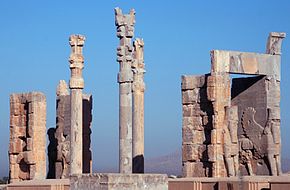Persepolis
| Pārseh | |

Ruins of the Gate of All Nations, Persepolis
|
|
| Location | Marvdasht, Fars Province, Iran |
|---|---|
| Coordinates | 29°56′04″N 52°53′29″E / 29.93444°N 52.89139°ECoordinates: 29°56′04″N 52°53′29″E / 29.93444°N 52.89139°E |
| Type | Settlement |
| History | |
| Builder | Darius I, Xerxes I and Artaxerxes I |
| Material | Stone and wood |
| Founded | 6th century BC |
| Periods | Achaemenid Empire |
| Cultures | Persian |
| Events | Nowruz, The 2,500 Year Celebration of the Persian Empire |
| Site notes | |
| Condition | In ruins |
| Management | Iranian Government |
| Public access | Open |
| Official name | Persepolis |
| Type | Cultural |
| Criteria | i, iii, vi |
| Designated | 1979 (3rd session) |
| Reference no. | 114 |
| State Party | Iran |
| Region | Asia-Pacific |
Persepolis (Greek: Περσέπολις, literally meaning "The city of the Persians"), Parseh (Persian: پارسه, literally meaning "The city of Persians"), also known as Takht-e-Jamshid (Persian: تخت جمشید, literally meaning "the throne of Jamshid"), was the ceremonial capital of the Achaemenid Empire (ca. 550–330 BC).
Persepolis is situated 60 km northeast of the city of Shiraz in Fars Province, Iran. The earliest remains of Persepolis date back to 515 BC. It exemplifies the Achaemenid style of architecture. UNESCO declared the ruins of Persepolis a World Heritage Site in 1979.
To the ancient Persians, the city was known as Pārseh (...
Wikipedia

